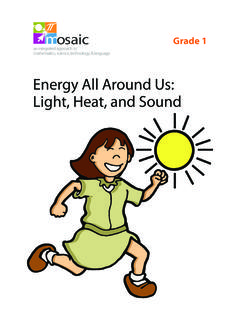Transcription of CLC Cellular light weight concrete
1 CLC Cellular light weight concrete Foam concrete is also Known as " Cellular light weight concrete ", "CLC", "Foamed cement", " light weight concrete " across the world with its greater advantages from 5 years. The basic foam concrete is made from mixing aqueeous foam which is produced from generators (IFG). into Slurry of Cement, fly ash OR sand, water and other additives in a precise mixing in foam concrete mixer(IFM) for accurate mixing without disturbing its original chemical and physical properties. Advantages light in weight High Thermal Insulation High Fire Protection High sound Insulation Lower Water Absorption Eco Friendly Economical Applications Blocks Cast Insuit Applications Panels Tank Infill Ceiling Panels Road Construction Pre-cast Exterior Walls Subway Infill Void Filling Tunnel Infill Roof Insulation Mine Infill Thermal Insulations Water Proof Material sound Insulation Floors Floors Low Cast Housing Advantages in detail: Savings in Raw Material: The tremendous savings described when using CLC are manifold, continuing with substantial savings in raw material (no gravel required), in dead load of high-rise reducing by almost half.
2 Considering that a substantial amount of steel is necessary only to carry the weight of the structure, steel requirement might reduce by hundreds of ton in high rise. Considerably Lower weight : weight reduction is obvious in transport, where almost double of volume of building material can be produced, it has an impact on craning, where either larger panels can be taken, or the full capacity in span. Alternatively less re- location of the crane is necessary. Thermal Insulation: Thermal Insulation increasingly turns to be the most important issue in the planning and construction of buildings. There are many costly ways of insulation on sandwich structure of a wall, adding the one or another rigid insulation material, with a satisfactory result by computation but not always a sound solution in safety, health or environment. The best solution is, to incorporate thermal insulation in the mix of a concrete , such offered in air-cured CLC. Fire Protection: The air-embedded in the CLC is also instrumental for the high fire- rating.
3 In 1200 kg/m density a 13-14 cm thick wall has a fire endurance of 5 hours. The same delay occurs with a 400 kg/m layer of CLC in only 10 cm thickness. CLC is otherwise non-combustible. sound Insulation: Over the efforts to keep on increasing the thermal capacity of building members, other aspects have been neglected, such as sound insulation. sound is experienced as air-borne or foot-fall sound (impact ). Air-borne it is a rule of density and therefore CLC offers superior protection than very light concrete (ACC). In impact sound it is superior to conventional concrete . Hitting a wall with a hammer, will let you feel the full force on the other side, whilst the air embedded in CLC will not allow the blow to pass through. At the most it will suffer a small dent and thereby prevent any greater damage. Insulated Flooring: As the impact force will not transmit, slabs produced of CLC or topped with a layer of CLC floor screen will prevent any sound being noticed in the room below.
4 Walls of CLC will also serve as sound retaining walls on roads or railway tracks therefore, absorbing the sound and preventing it from bouncing to the other side. Customisable Physical Properties: Adding fibers to CLC is a further important benefit, increasing bending stress substantially and most of it impact strength. The three dimensional acting fiber ( polypropylene) will further reduce shrinkage, therefore reducing water absorption and increasing strength (up to 25 %. This is appreciated most when producing slender building components. Economical Production: Using only flyash, cement, water and foam, the cost for one m . of CLC in most cases is less even than for the equivalent volume of conventional concrete . Adding all the described highly appreciated benefits (comprising CLC) to regular concrete , if at all possible, the cost for such regular concrete would probably double but still not reach the overall quality of CLC. Technical Specifications Walls of CLC have excellent sound insulation CLC Bricks are available in 3 grade strengths: Grade A: These are used as load bearing units & have a brick density in the range of 1,200.)
5 Kg/Cum 1,800 kg/Cum Grade B: These are used as non-Load bearing units & have a brick density in the range of 700 . 1,000 kg/Cum. Grade C: These are used for providing thermal insulation & have a brick density in the range of 400 600 kg/Cum. Technical Specifications of CLC Bricks: Brick Size (mm) Approximate weight /Brick (Kg) No. of Brick/Truck No. of 600 x 200 x 200 305 41. 600 x 200 x 150 416 55. 600 x 200 x 100 610 83. Grade wise comparison of CLC Bricks: Type Density Min. Compressive Strength N/mm2 Water Absorption %. Grade A 1800 1600 Type Density Min. Compressive Strength N/mm2 Water Absorption %. 1400 1200 Grade B 1000 800 Grade C 600 400 Recommended usage of CLC based on density: Density 300-600 kg/m : This density is primarily applied for thermal insulation or fire protection. It uses only cement (or little flyash), water and foam and can easily be pumped. Foam generators allow the production of stiff foam for slopes to be applied on roof-tops.
6 Density 700-800 kg/m : Is also used for void-filling, such as an landscaping (above underground construction), to fill voids behind archways and refurbishing of damaged sewerage systems. It is also been used to produce building blocks. Density 900-1100 kg/m : Serves to foremostly produce blocks and other non-load bearing building elements such as balcony railings, partitions, parapets and fence walls etc. Density 1200-1400 kg/m : Are the most commenly densities for prefab and cast in situ walls, load-bearing and non-load-bearing. It is also successfully used for floorscreeds ( sound and insulation plus weight reduction). Density 1600-1800 kg/m : would be recommended for slabs and other load-bearing building elements where higher strength is obligatory. Compare CLC. S. Parameters Cellular Lightweight concrete Bricks Burnt Clay Bricks No. Basic raw materials & Cement, Aggregate, Fly Ash, Water & Foaming 1. Top Soil & Energy other inputs Compound 2. General Properties Dry Density kg/m3 750 800 1900.
7 Compressive Strength 25 30 40-75. in kg/cm3. Range of applications / Load-bearing & non-load Partition utility bearing No gain in strength with Aging Gains strength with age age Thermal Conductivity for 800 kg/m3 ( ). sound Insulation Superior than burnt clay & hollow concrete Normal Ease of Working Can be cut, nailed & drilled Normal 3. Shape & Form Pre-cast Brick size 600 x 200 x 100/150/200 mm 230 x 100 x 70 mm Pre-cast elements Any size of elements Not feasible Cast in shape Any shape & size in any density Not feasible Water Absorption % by 4. 12% for 800 kg/m3 density (by volume) 20% by volume weight Drying Shrinkage 5. No shrinkage mm/meter 6. Productivity Output 100% more than brick work Normal 7. Eco Friendliness Creates smokeUses high Pollution freeLeast energy requriement Can energy Wastes consume fly ash around 33% agricultural land 55% reduction in weight of walls. Tremendous Structural saving due to 8. structural saving for high rise buildings in No additional saving dead weight reduction Earthquake / Poor soil area CLC Manufacturing CLC manufacturing setup is cheap & profitable and highly customisable.
8 Required Equipment MFG / MFG-A Foam Generator Conventional Mixers, pan-mixer, truck-mixer Conventional conveying system (buckets, concrete pumps etc). Conventional moulds, horizontal/vertical Raw Material flyash or sand (2, 4, 6, 8 mm, depending on density and availability). Preference Flyash min. 20% fines Cement, Preference Portland Water for Foam production: Potable Foaming Agent Optional Fibre: Polypropylene Fly-ash up to 40% on total mix Lightweight Aggregate ( expanded clay etc.). Production Procedure Flyash: Optimum properties are achieved when selecting the most suitable raw material (flyash, Cement). Preference : power-plant flyash, sieved and with minimum 20% fines. Impurities in flyash increases the demand for water and cement, without adding to the properties. It also increases shrinkage. A certain, small amount (20%) of fines contributes towards strength. As in conventional concrete (CC), the flyash should be free of organic material or other impurities.
9 Crushed sand, due to sharp edges may destroy the foam mechanically hence not recommended. Cement: Portland cement is preferred over other cements, such as pozzolan. For Early stripping and optimum mechanical properties, high- grade (early strength) cement is recommended. Thick walls and when using battery-moulds, excess heat is developing within and might therefore ask for a lesser grade of cement. Remember : The slower the hardening, the better the final quality of concrete . Where economical, fly-ash may be added to the mix to substitute some of the cement. Fly-ash normally will retard hardening though. Water: When used to produce foam, has to be potable and for best performance should not exceed 25 C. Under no circumstances must the foaming agent be brought in contact with any oil, fat, chemical or other material that might harm its function (Oil has an influence on the surface- tension of water). The oil/wax used in moulds will not harm, since the foam by then will be embedded in mortar.
10 Water to prepare the mix has to conform with general requirements for concrete Foaming Agent: The containers holding foaming agent must be kept air-tight and under temperatures not exceeding 25 C. This way the shelf-life is guaranteed for 24 months from date of Invoice. Once diluted in 4o parts of potable water, the emulsion must be used as soon as possible. Correct density of foam: The weight of the foam should be minimum 80 g/l. Use a containers of as close as possible to 10 liters in volume, to check the weight (density) of the foam. Smaller containers may not allow to pour foam into, without possible large voids. A fast check on the correct weight is also possible by turning the bucket with foam up-side down. If the weight of the foam is minimum 80 g/l and does not drop out of the bucket, the consistency of the foam is correct. After several weeks of experience the person in charge of producing foam will know the correct quality of the foam by sight.





